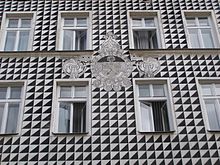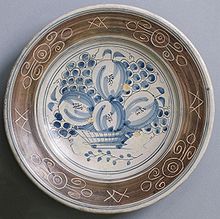This article needs additional citations for verification. (October 2015) |



Sgraffito (Italian: [zɡrafˈfiːto]; pl. sgraffiti) is an artistic or decorative technique of scratching through a coating on a hard surface to reveal parts of another underlying coating which is in a contrasting colour. It is produced on walls by applying layers of plaster tinted in contrasting colours to a moistened surface, and on pottery by applying two successive layers of contrasting slip or glaze to an unfired ceramic body.[1] The Italian past participle sgraffiato is also used for this technique, especially in reference to pottery.
Etymology
[edit]

The term sgraffito is based on the verb graffiare 'to scratch', which probably entered Italian through Lombardic and ultimately traces back to the Greek word gráphein 'to write'. The Italian prefix 's-' originates in the Latin prefix 'ex-', and is used in this case to intensify the basic meaning, so that 'to scratch' becomes 'to scratch off'.
History
[edit]Sgraffito on walls has been used in Europe since classical times. It was popularized in Italy in the 15th and 16th centuries[2] and can be found in African art. In combination with ornamental decoration, these techniques formed an alternative to the prevailing painting of walls. The technical procedure for sgraffito is relatively simple, resembling the process of painting frescoes.
Sgraffito played a significant role during the Italian Renaissance, with two of Raphael's workshops, Polidoro da Caravaggio and his partner Maturino da Firenze, among the leading specialists. They painted palace facades in Rome and other cities however most of their work has since weathered. During the 16th century, the technique was brought to Germany by the master builders of the Renaissance and taken up with enthusiasm. As a simple native art, old examples of sgraffito can be found in the wide surroundings of Wetterau and Marburg. In Germany, the technique is most predominant in Bavaria. The use of sgraffito was common in the creation of housing façades for the purposes of advertising. The technique was also used in Thuringia, the Engadin, Austria, and Transylvania.
In Catalonia, sgraffito gained prominence during the early 20th century, particularly through the influence of Noucentista neo-classical architects. This period marked a significant resurgence in interest in classical aesthetics and cultural identity, prompting architects to adopt sgraffito as a recurrent technique for embellishing façades. The intricate patterns and designs scratched into the plaster surfaces of buildings became emblematic of the region's architectural heritage, reflecting a harmonious blend of tradition and modernity. As sgraffito adorned numerous buildings throughout Catalonia, it served as a decorative element and a symbol of cultural revival and artistic innovation during a transformative period in the region's history.
Another application of sgraffito involves a simplified painting technique. Initially, a single coat of paint is applied and allowed to dry on a canvas or sheet of paper. Subsequently, a different color is painted over the first layer. Using a palette knife, oil stick, or similar tool, the artist then scratches out a design, revealing the underlying color. Alternatively, oil pastels may be used for the initial layer, with black ink applied on top. In some cases, the initial layer of paint may be omitted, and the artist scrapes back the wet coat to expose the canvas underneath. However, this method is not applicable when using oil pastels. This technique is frequently employed in art classes to introduce novice art students to the sgraffito technique.
In the process of stained glass creation, finely ground pigments of black, brown, and yellow colors, mixed with either water or glycerin, are delicately applied to sheet glass. Once the pigment mixture has dried, the artist can meticulously remove portions of it, revealing the light from beneath in intricate patterns. This technique of sgraffito is subtractive in nature, enabling the artist to work imagery into the surface of the glass. To permanently fuse the pigment to the glass, multiple firings in a kiln may be necessary. This firing process allows the maker to achieve high definition, contrast, and subtle gradients, utilizing a variety of tools to manipulate the pigment and create the desired effects.
Art Nouveau
[edit]Examples of graphic work on facades saw a resurgence c. 1890 through 1915, in the context of the rise of the Arts and Crafts Movement, the Vienna Secession, and particularly the Art Nouveau movement in Belgium and France.
The English artist Heywood Sumner has been identified[3] as this era's pioneer of the technique, for example his work at the 1892 St Mary's Church, Sunbury, Surrey. Sumner's work is sgraffito per se, scratched plaster, but the term has come to encompass a variety of techniques for producing exterior graphic decoration. The incorporation of floral motifs of intricate patterns that uses the contrast of the etching technique.
Although the technique was popularized during the renaissance period, the modern craft movement adopted its usages and have incorporated the styles throughout the crafts movement such as art nouveau that emerged in the late 19th and early 20th century in ceramics, glass, and metals.
Applications across different mediums
[edit]- Glass: Sgraffito can be seen in both blown and stained glass windows, where skilled artisans carve intricate designs into the surface of the glass, creating stunning visual effects when illuminated.
- Enamel: In the realm of enamelwork, sgraffito techniques are utilized to carve designs into the enamel surface, adding texture and dimension to the finished pieces.
- Ceramics and Pottery: Sgraffito is perhaps most commonly associated with ceramics and pottery, where artists scratch through layers of glaze or slip to reveal contrasting colors or the natural clay body beneath, resulting in striking surface decoration.
- Architecture: Sgraffito finds expression in architectural ornamentation, with elaborate designs adorning the facades of buildings, particularly in regions where the technique has historical significance.
- Furniture: Though less common, sgraffito can also be found in furniture design, particularly in northern European regions like Germany, Austria, and the Czech Republic. Here, it often appears as intricate patterns scratched onto wooden surfaces, adding a touch of folk art charm to furniture pieces.
Other examples include:
- Ceramic panels on the Grande Maison de Blanc, Brussels, architect Oscar François, artist Henri Privat-Livemont, 1896–1897
- The Hôtel Albert Ciamberlani, Brussels, architect Paul Hankar, sgraffito designs by Albert Ciamberlani and executed by Adolphe Crespin, 1897.
- The Golden House, Charleroi (Belgium), sgraffito designs by Gabriel Van Dievoet 1899.
- Princess of Dreams tile tympanum and other work, Hotel Metropol, Moscow, architect William Walcot, artist Mikhail Vrubel, 1899–1907
- Cauchie House, Brussels, architect Paul Cauchie, 1905
- Ceramic Homage to Prague tympanum of the Municipal House in Prague, architect Osvald Polívka, artist Karel Špillar, 1905–1912
Gallery
[edit]-
Palazzo Nasi, Florence
-
Building in Olomouc
-
Detail of Hôtel Albert Ciamberlani, Brussels
-
Golden House, sgraffiti by Gabriel van Dievoet, Charleroi, 1899.
-
Renaissance façade with sgraffito in Mödling
-
Renaissance façade with sgraffito in Althofen
-
Building in Barcelona
-
Town hall of Drosendorf-Zissersdorf
-
Building in Jindřichův Hradec
See also
[edit]References
[edit]- ^ Sgraffito. In: Weyer, Angela; Roig Picazo, Pilar; Pop, Daniel; Cassar, JoAnn; Özköse, Aysun; Jean-Marc, Vallet; Srša, Ivan (Ed.) (2015). Weyer, Angela; Roig Picazo, Pilar; Pop, Daniel; Cassar, JoAnn; Özköse, Aysun; Vallet, Jean-Marc; Srša, Ivan (eds.). EwaGlos. European Illustrated Glossary Of Conservation Terms For Wall Paintings And Architectural Surfaces. Petersberg: Michael Imhof. p. 102. doi:10.5165/hawk-hhg/233.
- ^ Henry, Alison; Stewart, John, eds. (2011). Practical building conservation. Mortars, plasters, and renders. Farnham/Burlington: Ashgate Publishing. p. 99.
- ^ Modern mural decoration by Alfred Lys Baldry, 1902
External links
[edit]- Sgraffito Collection of Museum Boijmans Van Beuningen, Rotterdam.
- St. Benet's Chaplaincy at Queen Mary, University of London










